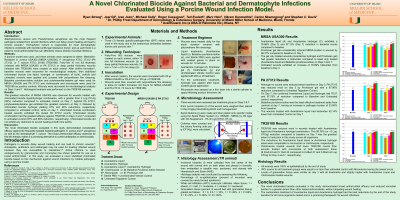Laboratory Research
(LR-044) A Novel Chlorinated Biocide Against Bacterial and Dermatophyte Infections Evaluated Using a Porcine Wound Infection Model
Friday, May 2, 2025
7:45 PM - 8:45 PM East Coast USA Time

Joel Gil, BS – Sr. Manager, Research Laboratory, Dermatology, University of Miami Miller School of Medicine; Michael Solis, MBA – Sr. Research Associate 1, Dermatology, University of Miami Miller School of Medicine; Roger Cassagnol, BS – Research Assistant, Dermatology, University of Miami Miller School of Medicine; Beatriz Abdo Abujamra, BS – Research Associate, Dermatology, University of Miami Miller School of Medicine; Ted Eveleth, PhD – CEO, AvantGuard, Inc (a DBA of Halomine Inc.); Marc Hein, PhD – AvantGuard, Inc (a DBA of Halomine Inc.); Vikram Kanmukhla, PhD – AvantGuard, Inc (a DBA of Halomine Inc.); Carine Nkemngong, PhD – AvantGuard, Inc (a DBA of Halomine Inc.); Ivan Jozic, PhD – Research Assistant Professor, Dermatology, University of Miami Miller School of Medicine; Stephen Davis, BS – Research Professor, Dermatology, University of Miami Miller School of Medicine
Introduction: Staphylococcus aureus and Pseudomonas aeruginosa are the most frequent pathogens isolated from wound infections which can delay wound healing and lead to chronic wounds.1 Trichophyton rubrum is responsible for most dermatophyte infections worldwide with reported antifungal resistance rising2, and as such there is a need for novel antimicrobial that can effectively reduce diverse microbial infections.
Methods: A porcine model was used, and three animals were assigned to either: Methicillin-Resistant S. aureus USA300 (MRSA USA300), P. aeruginosa ATCC 27312 (PA 27312), or T. rubrum ATCC 28188 (TR28188). Forty-five 10 mm full thickness (infected with MRSA USA300 or PA 27312) or deep partial thickness wounds (infected with TR28188) were created on each animal. After biofilm formation3, baseline wounds were recovered for microbiological analysis, then stabilized chlorinated biocide (via liquid, hydrogel, or combination of both), vehicle and untreated controls were applied and covered with polyurethane film dressing. Betadine povidone-iodine solution and polyhexanide-betaine gel were used for MRSA USA300 and PA 27312 and clotrimazole and miconazole were used for TR28188 as positive controls. Wounds were recovered for microbiological analysis on Days 3 and 7. Histological analysis was performed on the TR28188 samples.
Results: The greatest reduction of MRSA USA300 was observed for wounds treated with chlorinated biocide liquid/hydrogel combination, with a greater than 2 Log CFU/g (99%) reduction compared to untreated control on Day 7. Against PA 27312, polyhexanide-betaine gel exhibited the greatest reduction at Day 3, followed by chlorinated biocide hydrogel yielding 97% and 96% reductions, respectively compared to untreated control, while on day 7, chlorinated biocide combination treated wounds exhibited the lowest PA 27312 counts. Chlorinated biocide combination had the greatest efficacy against TR28188 on Days 3 and 7 compared to untreated control (97% and 98% reduction, respectively). Chlorinated biocide did not exhibit any detriment to wound healing at both time points.
Discussion: The novel chlorinated biocide evaluated in this study demonstrated considerable efficacy against the frequently isolated bacterial pathogens S. aureus and P. aeruginosa as well as the dermatophyte T. rubrum. The broad antimicrobial efficacy observed for this this therapy makes it a promising alternative to current antiseptics or antimicrobials.
Methods: A porcine model was used, and three animals were assigned to either: Methicillin-Resistant S. aureus USA300 (MRSA USA300), P. aeruginosa ATCC 27312 (PA 27312), or T. rubrum ATCC 28188 (TR28188). Forty-five 10 mm full thickness (infected with MRSA USA300 or PA 27312) or deep partial thickness wounds (infected with TR28188) were created on each animal. After biofilm formation3, baseline wounds were recovered for microbiological analysis, then stabilized chlorinated biocide (via liquid, hydrogel, or combination of both), vehicle and untreated controls were applied and covered with polyurethane film dressing. Betadine povidone-iodine solution and polyhexanide-betaine gel were used for MRSA USA300 and PA 27312 and clotrimazole and miconazole were used for TR28188 as positive controls. Wounds were recovered for microbiological analysis on Days 3 and 7. Histological analysis was performed on the TR28188 samples.
Results: The greatest reduction of MRSA USA300 was observed for wounds treated with chlorinated biocide liquid/hydrogel combination, with a greater than 2 Log CFU/g (99%) reduction compared to untreated control on Day 7. Against PA 27312, polyhexanide-betaine gel exhibited the greatest reduction at Day 3, followed by chlorinated biocide hydrogel yielding 97% and 96% reductions, respectively compared to untreated control, while on day 7, chlorinated biocide combination treated wounds exhibited the lowest PA 27312 counts. Chlorinated biocide combination had the greatest efficacy against TR28188 on Days 3 and 7 compared to untreated control (97% and 98% reduction, respectively). Chlorinated biocide did not exhibit any detriment to wound healing at both time points.
Discussion: The novel chlorinated biocide evaluated in this study demonstrated considerable efficacy against the frequently isolated bacterial pathogens S. aureus and P. aeruginosa as well as the dermatophyte T. rubrum. The broad antimicrobial efficacy observed for this this therapy makes it a promising alternative to current antiseptics or antimicrobials.

.jpg)